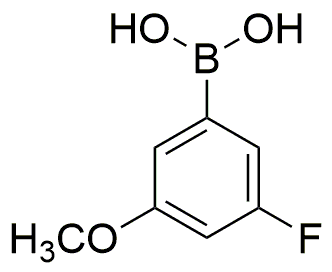3-Fluoro-5-methoxyphenylboronic acid is widely utilized in research focused on:
- Pharmaceutical Development: This compound is crucial in synthesizing various pharmaceuticals, particularly in the development of anti-cancer agents. Its boronic acid functionality allows for the formation of stable complexes with diols, enhancing drug efficacy.
- Organic Synthesis: It serves as a versatile building block in organic synthesis, facilitating the creation of complex molecules. Researchers often use it in Suzuki-Miyaura cross-coupling reactions, which are essential for forming carbon-carbon bonds.
- Material Science: The compound is employed in the development of advanced materials, including polymers and nanomaterials. Its unique properties contribute to improved material performance in various applications, such as electronics and coatings.
- Bioconjugation: It is used in bioconjugation techniques, where it helps in attaching biomolecules to surfaces or other molecules. This application is particularly valuable in creating targeted drug delivery systems and diagnostic tools.
- Analytical Chemistry: The compound plays a role in analytical methods, such as chromatography and mass spectrometry. Its ability to form complexes enhances the detection and quantification of various analytes, making it a useful tool in laboratories.
General Information
Properties
Safety and Regulations
Applications
3-Fluoro-5-methoxyphenylboronic acid is widely utilized in research focused on:
- Pharmaceutical Development: This compound is crucial in synthesizing various pharmaceuticals, particularly in the development of anti-cancer agents. Its boronic acid functionality allows for the formation of stable complexes with diols, enhancing drug efficacy.
- Organic Synthesis: It serves as a versatile building block in organic synthesis, facilitating the creation of complex molecules. Researchers often use it in Suzuki-Miyaura cross-coupling reactions, which are essential for forming carbon-carbon bonds.
- Material Science: The compound is employed in the development of advanced materials, including polymers and nanomaterials. Its unique properties contribute to improved material performance in various applications, such as electronics and coatings.
- Bioconjugation: It is used in bioconjugation techniques, where it helps in attaching biomolecules to surfaces or other molecules. This application is particularly valuable in creating targeted drug delivery systems and diagnostic tools.
- Analytical Chemistry: The compound plays a role in analytical methods, such as chromatography and mass spectrometry. Its ability to form complexes enhances the detection and quantification of various analytes, making it a useful tool in laboratories.
Documents
Safety Data Sheets (SDS)
The SDS provides comprehensive safety information on handling, storage, and disposal of the product.
Product Specification (PS)
The PS provides a comprehensive breakdown of the product’s properties, including chemical composition, physical state, purity, and storage requirements. It also details acceptable quality ranges and the product's intended applications.
Certificates of Analysis (COA)
Search for Certificates of Analysis (COA) by entering the products Lot Number. Lot and Batch Numbers can be found on a product’s label following the words ‘Lot’ or ‘Batch’.
*Catalog Number
*Lot Number
Certificates Of Origin (COO)
This COO confirms the country where the product was manufactured, and also details the materials and components used in it and whether it is derived from natural, synthetic, or other specific sources. This certificate may be required for customs, trade, and regulatory compliance.
*Catalog Number
*Lot Number
Safety Data Sheets (SDS)
The SDS provides comprehensive safety information on handling, storage, and disposal of the product.
DownloadProduct Specification (PS)
The PS provides a comprehensive breakdown of the product’s properties, including chemical composition, physical state, purity, and storage requirements. It also details acceptable quality ranges and the product's intended applications.
DownloadCertificates of Analysis (COA)
Search for Certificates of Analysis (COA) by entering the products Lot Number. Lot and Batch Numbers can be found on a product’s label following the words ‘Lot’ or ‘Batch’.
*Catalog Number
*Lot Number
Certificates Of Origin (COO)
This COO confirms the country where the product was manufactured, and also details the materials and components used in it and whether it is derived from natural, synthetic, or other specific sources. This certificate may be required for customs, trade, and regulatory compliance.


